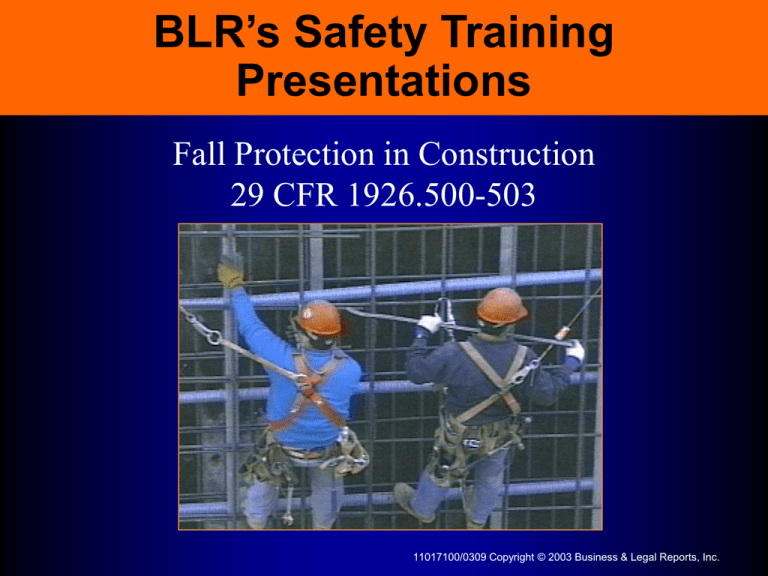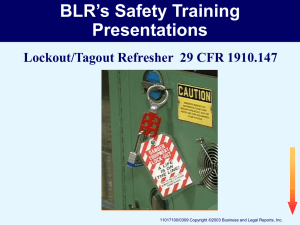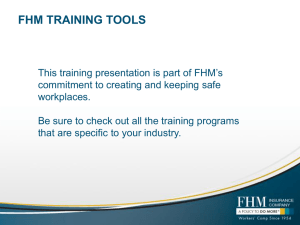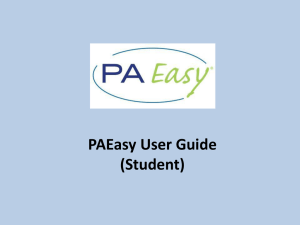When Is Fall Protection Needed?
advertisement

BLR’s Safety Training Presentations Fall Protection in Construction 29 CFR 1926.500-503 11017100/0309 Copyright © 2003 Business & Legal Reports, Inc. Goals Fall hazards and basic fall protection systems Guardrails and personal fall arrest systems Quiz 11017100/0309 Copyright © 2003 Business & Legal Reports, Inc. Construction Fall Statistics Leading cause of construction industry fatalities 150-200 workers are killed from falls each year 100,000 are injured from falls each year 11017100/0309 Copyright © 2003 Business & Legal Reports, Inc. Protecting Workers from Fall Hazards Assess where fall protection is needed Select fall protection systems Properly install fall protection systems Follow safe work procedures Train construction workers 11017100/0309 Copyright © 2003 Business & Legal Reports, Inc. When Is Fall Protection Needed? 6 feet or more above a lower level Hazard of falling into dangerous equipment Specific areas or activities 11017100/0309 Copyright © 2003 Business & Legal Reports, Inc. Safe Work Practices Pick up tripping hazards Be aware of your location Always use fall protection Avoid dropping objects Never run Listen for verbal warnings 11017100/0309 Copyright © 2003 Business & Legal Reports, Inc. Warning Line System Consists of ropes, wires, chains Must be flagged every 6 feet Must be 34-39 inches above working surface Stanchions must not tip over easily Must be erected at least 6 feet from the fall hazard Workers must be trained to stay out 11017100/0309 Copyright © 2003 Business & Legal Reports, Inc. Safety Monitoring System Competent person monitors safety of workers Recognizes fall hazards Warns workers of fall hazards and unsafe work practices Keeps unauthorized workers out of work area Workers promptly comply with safety monitor 11017100/0309 Copyright © 2003 Business & Legal Reports, Inc. Controlled Access Zones Keep unauthorized workers out Allow leading edge work without fall protection systems Are designated and clearly marked work areas Lines run the length of the unprotected edge Lines are 6-25 feet away from unprotected edge 11017100/0309 Copyright © 2003 Business & Legal Reports, Inc. Safety Net System Installed under walking/working surface <30 feet below workers Inspected for wear, damage Installed with sufficient clearance Items that fall into the net removed 11017100/0309 Copyright © 2003 Business & Legal Reports, Inc. Goals Fall hazards and basic fall protection systems Guardrails and personal fall arrest systems Quiz 11017100/0309 Copyright © 2003 Business & Legal Reports, Inc. Guardrail Systems Top rails must be 39-45 inches above the walking or working surface Top rails must withstand 200 lb force Mid-rails must be between top rail and working surface Toe boards must be 3.5 inches Screens must be installed from top rail to working surface 11017100/0309 Copyright © 2003 Business & Legal Reports, Inc. Guardrail Systems Openings must be 19 inches or less Rails must be smooth with no projections When guardrails are removed at hoisting areas, personal fall arrest systems shall be used Holes, excavations, and ramps must be protected 11017100/0309 Copyright © 2003 Business & Legal Reports, Inc. Prevent Falling Objects Use screens or panels Store materials 4 feet from edge For roofing work, store material 6 feet from edge Use canopies strong enough to prevent collapse and prevent penetration Keep tools, materials, and debris picked up Don’t throw objects down to lower levels Wear a hard hat 11017100/0309 Copyright © 2003 Business & Legal Reports, Inc. Uses for Personal Fall Arrest Systems 6 feet above a lower level Worker positioning Worker restraint Climbing ladders, scaffolding, rebar 11017100/0309 Copyright © 2003 Business & Legal Reports, Inc. Effective Fall Arrest System Maximum arresting force of 1,800 lb Free fall no more than 6 feet Avoid contact with a lower level Max deceleration distance of 3.5 feet Designed to withstand twice the impact forces 11017100/0309 Copyright © 2003 Business & Legal Reports, Inc. Harness vs. Body Belt Body belt not used for fall protection since January 1, 1998 Body belt may be used as worker restraint Harness distributes arresting forces Harness can be used for fall arrest, positioning, or suspension 11017100/0309 Copyright © 2003 Business & Legal Reports, Inc. Connectors and Snaphooks Snaphooks lock in place Nonlocking snaphooks are prohibited Do not engage snaphooks to the following –Webbing or rope –Another snap hook –D-ring with another snaphook attached –Horizontal lifeline –Object incompatible in shape or dimension 11017100/0309 Copyright © 2003 Business & Legal Reports, Inc. Lanyards Connect harness to lifeline or anchor Stretching or tearing system absorbs shock Prevent bouncing to reduce arrest forces No knots or wrapping around sharp objects 11017100/0309 Copyright © 2003 Business & Legal Reports, Inc. Lifelines Lifelines connect personal fall arrest system to anchor Vertical—hang from one anchor point Horizontal—stretched between two anchor points Ropes and straps made of synthetic fibers Protect against being cut or abraded 11017100/0309 Copyright © 2003 Business & Legal Reports, Inc. Deceleration Device Dissipates energy during fall arrest Rip-stitch, tearing, or stretching lanyard Rope grab device Retracting lifelines or lanyards 11017100/0309 Copyright © 2003 Business & Legal Reports, Inc. Anchor Points Anchors used only for personal fall arrest systems Anchors support 5,000 lb per person Located directly above you Do not tie to a guardrail Ask if unsure about proper anchor points 11017100/0309 Copyright © 2003 Business & Legal Reports, Inc. Inspecting Personal Fall Arrest Systems Inspect before each use Check D-rings for cracking, breaking, deformation Check straps for cuts, tears, abrasions, torn stitches Ensure that parts move freely Remove defective components from service 11017100/0309 Copyright © 2003 Business & Legal Reports, Inc. Rescue Plan Limit suspension time Suspension trauma occurs when legs are immobile in an upright position Push legs against objects Get legs up to head 11017100/0309 Copyright © 2003 Business & Legal Reports, Inc. Goals Fall hazards and basic fall protection systems Guardrails and personal fall arrest systems Quiz 11017100/0309 Copyright © 2003 Business & Legal Reports, Inc. Summary Learn to recognize and minimize fall hazards Be able to erect, maintain, and disassemble fall protection Use and operate fall protection systems Inspect fall protection systems Protect others from falling objects 11017100/0309 Copyright © 2003 Business & Legal Reports, Inc. Quiz 1. When is fall protection required? 2. How tall is the top rail of a guardrail system? 3. When do items that have fallen into safety nets need to be removed? 4. Warning lines must be flagged at 6-foot intervals. True or False 5. What type of work is commonly done in a controlled access zone? 11017100/0309 Copyright © 2003 Business & Legal Reports, Inc. Quiz (cont.) 6. Name two things you can do to prevent objects from falling to a lower level. 7. What do you look for when inspecting your harness and lanyard? 8. Your personal fall arrest system must limit free fall distance to 8 feet. True or False 9. How do lanyards reduce arresting forces from a fall? 10. Guardrails make effective anchor points for personal fall arrest. True or False 11017100/0309 Copyright © 2003 Business & Legal Reports, Inc. Quiz Answers 1. Working 6 feet above a lower level 2. 39-45 inches above working surface 3. As soon as possible and at least before the next shift 4. True 5. Overhand bricklaying 11017100/0309 Copyright © 2003 Business & Legal Reports, Inc. Quiz Answers 6. Screens, store materials 4 feet from edge, canopies, toe boards, pick up tools and debris 7. Check straps for tears, abrasions, loose stitches; check D-rings for cracks, deformities 8. False, 6 feet 9. Stretching or tearing system absorbs shock and prevents bouncing 10. False, only use anchors that are designed for personal fall arrest systems. 11017100/0309 Copyright © 2003 Business & Legal Reports, Inc.









